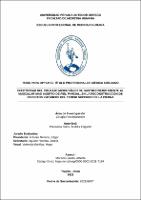| dc.contributor.advisor | Moreno Lázaro, Alberto | |
| dc.contributor.author | Plasencia Salini, Andrés Edgardo | |
| dc.creator | Plasencia Salini, Andrés Edgardo | |
| dc.date.accessioned | 2021-08-12T22:33:06Z | |
| dc.date.available | 2021-08-12T22:33:06Z | |
| dc.date.issued | 2021 | |
| dc.identifier.uri | https://hdl.handle.net/20.500.12759/7899 | |
| dc.description.abstract | Se realizó un estudio donde comparamos dos técnicas quirúrgicas las cuáles
están indicadas en pacientes con patologías que ocasionan pérdida de tejido blando en el
tercio superior de la pierna y se evidenció cual tuvo mayor efectividad.
Material y métodos: El trabajo de investigación fue de tipo observacional, analítico, de cohorte,
retrospectivo que se realizó en el Hospital Victor Lazarte Echegaray, Trujillo, Perú, entre
diciembre del 2019 y Febrero del 2020. Se realizó la recopilación de información de las historias
clínicas con fechas de Enero de 1993 a Diciembre del 2018. La población de pacientes estudiados
fue 67, 55 varones y 12 mujeres, con edades promedio de 47.3 años. Se distribuyeron en dos
cohortes; grupo A, colgajo miocutaneo de gastrocnemio, y el grupo B, colgajo muscular de
gastrocnemio más injerto de piel parcial, que fueron las dos técnicas quirúrgicas realizadas.
Resultados: En el grupo A, 36 pacientes tuvieron éxito en su cirugía reconstructiva y en 1 el
colgajo no fue viable, mientras que en el grupo B, 25 pacientes tuvieron éxito en su intervención y
en 5 el colgajo no fue viable. Por lo tanto, evidenciamos que el colgajo miocutaneo de
gastrocnemio tiene mayor incidencia de efectividad del 97,3% frente a un 83,3% del grupo de
pacientes tratados con colgajo muscular de gastocnemio más injerto de piel parcial (RR: 1,17)
Conclusiones: El colgajo miocutaneo de gastrocnemio presenta una mayor incidencia de
efectividad frente a los colgajos musculares más injerto de piel parcial en pacientes con
defectos cutáneos del tercio superior de la pierna en relación de 1.17 a 1. | es_PE |
| dc.description.abstract | We made a study where we compared two surgical techniques which are indicated
in patients with pathologies that cause a loss of soft tissue in the upper third of the leg and we
show which one is more effective.
Material and Methods: An observational, analytical, cohort, retrospective study was carried out
at the Victor Lazarte Echegaray Hospital, Trujillo, Peru, between December 2019 and February
2020. The information was collected from the medical records with dates from January 1993 to
December 2018. The population studied were 67, 55 males and 12 females with average ages of
47.3 years. They were divided in two cohorts, given by group A, gastrocnemius myocutaneous
flap, and group B, gastrocnemius muscle flap plus partial skin graft, which were the two surgical
techniques performed on them.
Results: In the group A, 36 patients were successful in their reconstructive surgery and 1 had a
failed flap, while in group B, 25 patients were successful in their intervention and 5 had a failed
flap.
Therefore, we show that gastrocnemius myocutaneous flap have a greater efficacy of 97.3%
compared to 83.3% of the group of patients treated with an gastrocnemius muscle flap plus a
partial skin graft (RR : 1.17)
Conclusion: The gastrocnemius myocutaneous flap has a higher incidence of superior
effectiveness compared to muscle flaps plus partial skin graft in patients
with skin defects of the upper third of the leg in a ratio of 1.17 to 1 | en_US |
| dc.description.uri | Tesis | es_PE |
| dc.format | application/pdf | es_PE |
| dc.language.iso | spa | es_PE |
| dc.publisher | Universidad Privada Antenor Orrego | es_PE |
| dc.relation.ispartofseries | T_MED_3079 | |
| dc.rights | info:eu-repo/semantics/openAccess | es_PE |
| dc.rights.uri | https://creativecommons.org/licenses/by/4.0/ | es_PE |
| dc.source | Universidad Privada Antenor Orrego | es_PE |
| dc.source | Repositorio Institucional - UPAO | es_PE |
| dc.subject | Colgajo Miocutaneo de Gastrocnemio | es_PE |
| dc.subject | Reconstrucción | es_PE |
| dc.title | Efectividad del colgajo mocutáneo de gastrocnemio frente al muscular más injerto de piel parcial, en la reconstrucción de defectos cutáneos del tercio superior de la pierna | es_PE |
| dc.type | info:eu-repo/semantics/bachelorThesis | es_PE |
| thesis.degree.level | Título Profesional | es_PE |
| thesis.degree.grantor | Universidad Privada Antenor Orrego. Facultad de Medicina Humana | es_PE |
| thesis.degree.name | Médico Cirujano | es_PE |
| thesis.degree.discipline | Medicina Humana | es_PE |
| dc.subject.ocde | https://purl.org/pe-repo/ocde/ford#3.02.27 | es_PE |
| renati.advisor.orcid | https://orcid.org/0000-0002-3031-7194 | es_PE |
| renati.author.dni | 71559998 | |
| renati.advisor.dni | 17870285 | |
| renati.type | https://purl.org/pe-repo/renati/type#tesis | es_PE |
| renati.level | https://purl.org/pe-repo/renati/level#tituloProfesional | es_PE |
| renati.discipline | 912016 | es_PE |
| renati.juror | Arévalo Moreno, Edgar | |
| renati.juror | Aguirre Herrera, Josefa | |
| renati.juror | Valencia Mariñas, Hugo | |
| dc.publisher.country | PE | es_PE |


